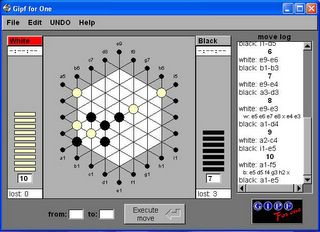Gipf for One
Name: Gipf for One
Author: Kurt Van den Branden
License: GNU General Public License
Website: http://gf1.sourceforge.net/
Gipf is one of the best two-player abstract strategy games released in last ten years. It was named the best abstract game in 1998 by Games Magazine. Gipf is played on a hexagonal grid. Each player starts with a reservoir of twelve pieces. A turn consists of taking a piece from the reservoir, placing it on the edge of the board, and pushing it onto the board. Any neighboring pieces get pushed along the same line. If after moving, four or more pieces of the same color form a row, they are removed along with any adjacent opponent pieces in the same row. The player's pieces are returned to their reservoir. The opponent's pieces are captured and removed from the game. The first player whose reservoir runs dry loses.
The strategy is fascinating. You want to threaten captures while avoiding getting your own pieces captured. You also want to maintain a supply of pieces in your reservoir. This often means completing rows of four with no captures just to replenish your reservoir. To keep your opponent from replenishing their reservoir, you often need to disconnect their pieces with a timely push. As a testament to the depth of Gipf, even after a few hundred games, I still do not have a good feel for what strategically makes a good position besides the obvious captured piece count.
Gipf for One (GF1) is a very good computer version of Gipf. It has human vs human and human vs computer modes, and is a great way to learn how to play the game. GF1 has crisp graphics and a simple, intuitive interface. It also plays a strong game. There are eight strength levels. Level 3 beats me far more often than I beat it, and I have never beaten level 4. GF1 mixes in a little randomness so that each game is different.

There are actually three sets of rules for the game Gipf: basic, standard, and tournament. The basic version was briefly described above. The standard game adds to the game three "Gipf Pieces" for each side. These are special pieces and have additional powers. However, you must keep at least one on the board, or you lose. The tournament rules adds another layer by allowing the player to choose the number of Gipf Pieces. GF1 implements all three rule sets.
Gipf is the first game in the Gipf Project, a collection of six abstract strategy game. There is a computer version for one of the other games. It is aptly named Zertz for One.

0 Comments:
Post a Comment
<< Home